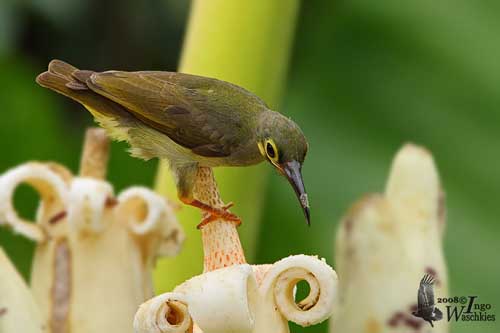
Fr: Arachnothère à lunettes
All: Brillenspinnenjäger
Esp: Arañero de Anteojos
Ita: Mangiaragni orecchiegialle maggiore
Nd: Geeloorspinnenjager
Sd: Glasögonspindeljägare
Photographer:
Ingo Waschkies
Bird Photography
Text by Nicole Bouglouan
Sources:
HANDBOOK OF THE BIRDS OF THE WORLD Vol 13 by Josep del Hoyo-Andrew Elliot-Jordi Sargatal - Lynx Edicions – ISBN: 9788496553453
A Field Guide to the Birds of South-East Asia by Craig Robson. New Holland Publishers. ISBN: 9781780090498
L’ENCYCLOPEDIE MONDIALE DES OISEAUX - Dr Christopher M. Perrins - BORDAS - ISBN: 2040185607
SUNBIRDS by Roberts A. Cheke, Clive F. Mann and Richard Allen Helm, 2001 - ISBN : 1873403801
BirdLife International (BirdLife International)
Generalities Spiderhunters: Wikipedia, the free encyclopaedia
Spectacled Spiderhunter
Arachnothera flavigaster
Passeriformes Order – Nectariniidae Family
INTRODUCTION:
The Spectacled Spiderhunter is a bird of Tropical Asia. Spiderhunters are robust and larger than most sunbirds. Sexes are similar and both parents incubate the eggs. This species is the heaviest of all Nectariniidae with a weight of 49 grams.
Unlike the name implies, this bird does not feed only on spiders, but also takes insects, fruits and nectar.
DESCRIPTION OF THE BIRD:
Biometrics:
Length: 21-22 cm
Weight: M: 45-49 g – F: 38 g
The adult has mostly olive plumage but the upperparts are more greenish. On the upperwing, the flight-feathers show brighter olive-green edges with bronzy wash. The tail is similar.
On the underparts, the plumage is paler than above, with more yellow on flanks and belly. The underwing is pale olive too.

The head is olive and shows prominent yellow patch on ear-coverts, and broad, bare, yellow eyering.
The long, broad-based, curved bill is blackish, with reddish lower base. The eyes are dark brown. Legs and feet are yellowish-brown.
Both sexes are similar.
The juvenile shows orange-red bill base, legs and feet.
RANGE:
The Spectacled Spiderhunter is resident in Sumatra and Borneo, but it is uncommon to rare in Borneo. The species is a fairly common resident in SW and S Thailand and Peninsular Malaysia. It was formerly in Singapore too.

HABITAT:
The Spectacled Spiderhunter frequents subtropical and tropical moist forests, both in lowland and mountainous areas. It can be found at forest edges, in clearings, plantations, cultivated areas and gardens.
This species can be seen from sea-level up to 1600-1800 metres according to the range, but generally, it occurs between sea-level and 600 metres of elevation.
CALLS AND SONGS: SOUNDS BY XENO-CANTO
The Spectacled Spiderhunter’s flight call is a loud, deep “chit’it, chut’ut” or “cha-tak”, sometimes longer “cha-ta-tak”. These calls are also uttered from perches. Spiderhunters have usually simple calls, metallic ‘chip” and similar short notes.
The song is a repetition of these notes, a monotonous series of sounds.

BEHAVIOUR IN THE WILD:
The Spectacled Spiderhunter has mixed diet. It feeds on spiders (Araneae), insects (Orthoptera and Formicidae), pollen, fruits and nectar.
Spiders are caught from their webs while the bird is hovering in front of its prey. While hovering, it also performs leaf-gleaning in order to catch insects and other spiders.
The Spectacled Spiderhunter feeds also on nectar. Its long tongue forms a tube and splits off into two incomplete tubes at tip. This very well adapted tool is used for extracting nectar from corollas. It hovers in front of the flowers while sucking the nectar. The nectar is taken from several flower species such as Eugenia, Spathodea, Jacaranda and several others.
The Spectacled Spiderhunter forages alone and occasionally in pairs. They may feed in small groups after the breeding season at fruit sources. It forages between mid and upper level in vegetation, but more often high in trees. It assists the plants in pollination process. It defends a feeding territory and can be aggressive against other spiderhunters.

The courtship behaviour of the Spectacled Spiderhunter is poorly known. Copulation usually follows some displays by males such as aerial chases, wing-flicking and flights. The head pattern is probably enhanced by adapted postures. These birds seem to be monogamous.
The Spectacled Spiderhunter is resident in its range.
While hovering in front of flowers, the wings produce a distinctive vibrating noise. The flight is usually undulating and accompanied by calls.

REPRODUCTION OF THIS SPECIES:
The breeding season occurs between February and September, but it may vary according to the range.
The nest is a round basket made with plant fibres and lined with seed pappus. This structure is usually attached by spider webs to the underside of leaf (coconut or palm frond). It can be placed too between rubber tree leaves (Ficus elastic). The nest is built between 5 and 10 metres above the ground.
The female lays 2 pale grey eggs, slightly tinged greenish with dark markings. Both male and female incubate during 13-15 days. The young fledge 14-19 days after hatching.

PROTECTION / THREATS / STATUS:
The Spectacled Spiderhunter is variably common to uncommon according to the range. This species is suspected to be in decline, due to continuous habitat destruction. But currently, it is not considered as threatened and it is evaluated as Least Concern.
